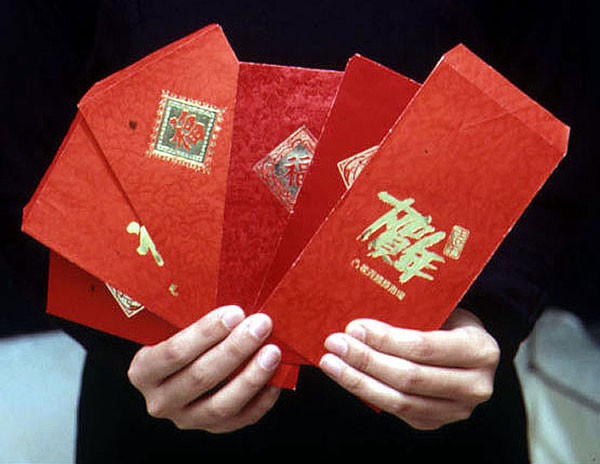
New Year Activities in China and Japan
Chinese and Japanese New Year are very different from the west. What actually happens on New Year's Day?
Chinese New Year lasts for 15 days, here is what Chinese do from new year eve to day 15.
New Year Eve:
The entire house should be cleaned before New Year's Day. Sweeping should not be done on New Year's Day for fear that good luck will be swept away. After cleaning up the house, people will start decorating the house. On walls and doors, people will paste poetic couplets; happy wishes likeˇ§wishing you good health", "Wishing you good year" etc. Those will be written on red paper. And family members eat dinner called "reunion dinner", play mahjong, make dumplings for whole night.
New Year Day (Day 1):
On New Year's Day, everybody should wear new clothes. This is what we call "bringing in the new and expelling the old" for the New Year. Chinese are very superstitious in all these special and traditional days. The very first thing we do on this day is to greet our parents and receive red pockets with money inside from them. Then, the family starts to say greetings out from door to door, first their relatives and then their neighbors. It is a great time for reconciliation. The atmosphere is filled with warmth and happiness.

|
| c.01Red Pockets |
One of the most traditional events during the Chinese New Year Festival is the Dragon and Lion Dance. On the street, The heads of these fearsome beasts are supposed to ward off evil, and the nimble movements of the dancers provide a grand spectacle enjoyable moment to everyone.
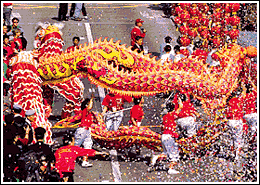 |
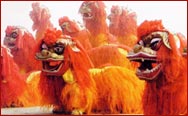 |
c.02Dragon
Dance |
c.03Lion Dance |
On New Year, people will also go to the temple and make wishes for the year.
 c.04
c.04
Day 3:
Everybody stays home because it is what we call the "red mouth" day, people will likely jump into a fight. But nowadays not that many people care about it anymore.
Day 5:
Businesses will open again, everybody gets back to work. Before they start their business at their office, they will fire firecrackers.
Day 7:
Day 7 is what we call the "People's Day", we say it's everybody's birthday, so family and relatives will get together and have a great dinner.
The Lantern Festival (Day 15):
People go to lanterns street fair. There will be many lanterns displayed on the streets. People go up there and ask for one lantern. In lanterns, there are some riddles for people to guess, and of course there are prizes for the winners. So, they will pull the riddle out the lantern and you have to guess the answer for it. The origin of lantern festival also have an interesting story behind it. One typical food is the Tong Yuan, another kind of dumplings made of sweet rice rolled into balls and stuffed with either sweet or spicy fillings. It symbolizes family reconciliation.
 |
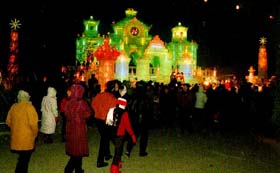 |
| c.05 | c.06 |
Japanese New Year, "Oshougatsu," literally meaning " a new month.
Cleaning up the house is one of the most to-do's before having New Year as well as Chinese. People organize inside and outside their houses so that they can welcome the new year with refreshed environment.
After cleaning is done, we decorate the houses. The most dominant decoration that we do is called "kadomatsu" shown in the picture below. These are to put at the entrance of your ouse and are maily made of bamboos. This is considered to be a sign for the god that we welcome, to let him know that we welcome him and lead him into the house.
On the other hand, "kagamimochi" is the most common decoration inside the house (also refer to the picture). This consists of "mochi", rice cake, some fruit and leaves to help the mochi look more gorgeous. Usually, there is no restriction for locating "kagamimochi" in the house, therefore, people tend to put it in a couple of locations such as on the shelves, in the kitchen and even bathroom because "kagamimochi" is a place for the god to stay in.
Cooking is the one of the main jobs that most women have to take care of before New Year's Day. Our New Year's Day now lasts for 3 days and during that time, we maily eat food called "osechi ryouri" which covers for 3 days. We have to prepare food that we can eat for 3 days, so that women do not need to cook much food during New Year time and thay can take a break.
 |
 |
j.01 Kadomatsu |
j.02 Kagamimochi |
On New Year's Eve in Japan, December 31, people eat noodles
at almost midnight to wish for long lives. (Long noodles symbolize long lives).
We also listen to bells rang 108 times. This is held in mostly all temples in
Japan. 108 bells mean 108 desires or passions that human have based on Buddhism
ideas. Listening to the bells, people believe that they can get rid of the old
year and welcome the new year. Some people stay home for New Year's Eve with
family and relax, and some people try to go out and have a party with friends.
On New Year's Day, people greet each other saying ˇ§akemashite omedetou gozaimasu.ˇ¨ Children and other young generations can get a pocket money in a small but very neat pouch from their parents, relatives and older generations. They meet and eat osechi ryouri in which each food has a detailed meaning.
Before or after that, many people schedule their first visit of the year to a shrine and go pray there for the new year. All the shrines tend to get very crowded at this time, especially around midnight of January 1, however, they still are packed with people afternoon.
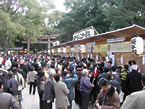
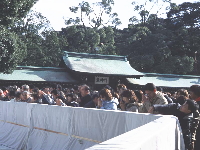 j.03,
04 People visiting shrine.
j.03,
04 People visiting shrine.
Well, our New Year in Japan is pretty much it. On January 1, we have a lot to do, however, after the second day we do not have particular schedule or custom that we should be doing. Some people visit their friends' houses for New Year's greetings, eat a lost of good foor or maybe take a trip to spend the rest of the holidays.